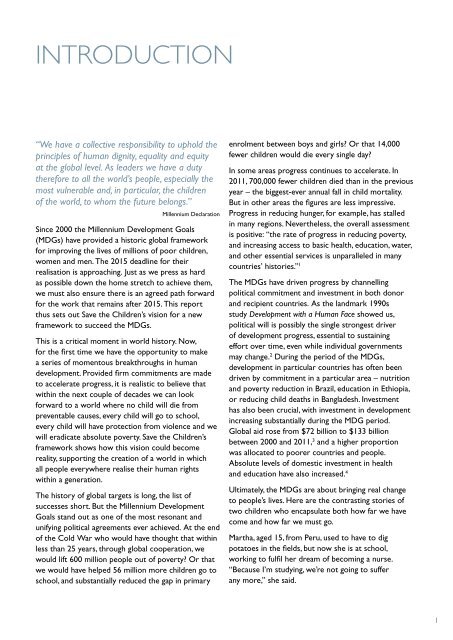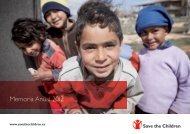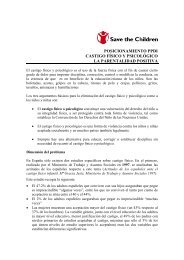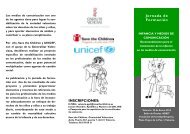ENDING poverty - Save the Children
ENDING poverty - Save the Children
ENDING poverty - Save the Children
Create successful ePaper yourself
Turn your PDF publications into a flip-book with our unique Google optimized e-Paper software.
INTRODUCTION<br />
“We have a collective responsibility to uphold <strong>the</strong><br />
principles of human dignity, equality and equity<br />
at <strong>the</strong> global level. As leaders we have a duty<br />
<strong>the</strong>refore to all <strong>the</strong> world’s people, especially <strong>the</strong><br />
most vulnerable and, in particular, <strong>the</strong> children<br />
of <strong>the</strong> world, to whom <strong>the</strong> future belongs.”<br />
Millennium Declaration<br />
Since 2000 <strong>the</strong> Millennium Development Goals<br />
(MDGs) have provided a historic global framework<br />
for improving <strong>the</strong> lives of millions of poor children,<br />
women and men. The 2015 deadline for <strong>the</strong>ir<br />
realisation is approaching. Just as we press as hard<br />
as possible down <strong>the</strong> home stretch to achieve <strong>the</strong>m,<br />
we must also ensure <strong>the</strong>re is an agreed path forward<br />
for <strong>the</strong> work that remains after 2015. This report<br />
thus sets out <strong>Save</strong> <strong>the</strong> <strong>Children</strong>’s vision for a new<br />
framework to succeed <strong>the</strong> MDGs.<br />
This is a critical moment in world history. Now,<br />
for <strong>the</strong> first time we have <strong>the</strong> opportunity to make<br />
a series of momentous breakthroughs in human<br />
development. Provided firm commitments are made<br />
to accelerate progress, it is realistic to believe that<br />
within <strong>the</strong> next couple of decades we can look<br />
forward to a world where no child will die from<br />
preventable causes, every child will go to school,<br />
every child will have protection from violence and we<br />
will eradicate absolute <strong>poverty</strong>. <strong>Save</strong> <strong>the</strong> <strong>Children</strong>’s<br />
framework shows how this vision could become<br />
reality, supporting <strong>the</strong> creation of a world in which<br />
all people everywhere realise <strong>the</strong>ir human rights<br />
within a generation.<br />
The history of global targets is long, <strong>the</strong> list of<br />
successes short. But <strong>the</strong> Millennium Development<br />
Goals stand out as one of <strong>the</strong> most resonant and<br />
unifying political agreements ever achieved. At <strong>the</strong> end<br />
of <strong>the</strong> Cold War who would have thought that within<br />
less than 25 years, through global cooperation, we<br />
would lift 600 million people out of <strong>poverty</strong>? Or that<br />
we would have helped 56 million more children go to<br />
school, and substantially reduced <strong>the</strong> gap in primary<br />
enrolment between boys and girls? Or that 14,000<br />
fewer children would die every single day?<br />
In some areas progress continues to accelerate. In<br />
2011, 700,000 fewer children died than in <strong>the</strong> previous<br />
year – <strong>the</strong> biggest-ever annual fall in child mortality.<br />
But in o<strong>the</strong>r areas <strong>the</strong> figures are less impressive.<br />
Progress in reducing hunger, for example, has stalled<br />
in many regions. Never<strong>the</strong>less, <strong>the</strong> overall assessment<br />
is positive: “<strong>the</strong> rate of progress in reducing <strong>poverty</strong>,<br />
and increasing access to basic health, education, water,<br />
and o<strong>the</strong>r essential services is unparalleled in many<br />
countries’ histories.” 1<br />
The MDGs have driven progress by channelling<br />
political commitment and investment in both donor<br />
and recipient countries. As <strong>the</strong> landmark 1990s<br />
study Development with a Human Face showed us,<br />
political will is possibly <strong>the</strong> single strongest driver<br />
of development progress, essential to sustaining<br />
effort over time, even while individual governments<br />
may change. 2 During <strong>the</strong> period of <strong>the</strong> MDGs,<br />
development in particular countries has often been<br />
driven by commitment in a particular area – nutrition<br />
<br />
or reducing child deaths in Bangladesh. Investment<br />
has also been crucial, with investment in development<br />
increasing substantially during <strong>the</strong> MDG period.<br />
Global aid rose from $72 billion to $133 billion<br />
between 2000 and 2011, 3 and a higher proportion<br />
was allocated to poorer countries and people.<br />
Absolute levels of domestic investment in health<br />
and education have also increased. 4<br />
Ultimately, <strong>the</strong> MDGs are about bringing real change<br />
to people’s lives. Here are <strong>the</strong> contrasting stories of<br />
two children who encapsulate both how far we have<br />
come and how far we must go.<br />
Martha, aged 15, from Peru, used to have to dig<br />
potatoes in <strong>the</strong> fields, but now she is at school,<br />
working to fulfil her dream of becoming a nurse.<br />
“Because I’m studying, we’re not going to suffer<br />
any more,” she said.<br />
1
















